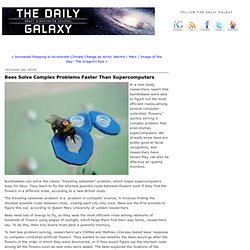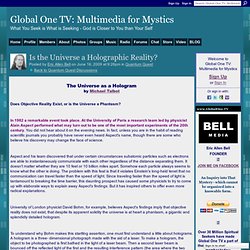

Sea slug has taken genes from algae it eats, allowing it to photosynthesize like a plant. How a brilliant-green sea slug manages to live for months at a time "feeding" on sunlight, like a plant, is clarified in a recent study published in The Biological Bulletin.

The authors present the first direct evidence that the emerald green sea slug's chromosomes have some genes that come from the algae it eats. These genes help sustain photosynthetic processes inside the slug that provide it with all the food it needs. Importantly, this is one of the only known examples of functional gene transfer from one multicellular species to another, which is the goal of gene therapy to correct genetically based diseases in humans.
Engeneering. Energy. Electricity. Computers. Chemistry. Astronomy. Technology. Psycology. How to Make Your Own Glowing Light Bulbs That Don't Need Electricity. Ten Most Extreme Substances Known to Man. This Will Mindfuck You: The Double-Slit Experiment. The video below shows scientific proof that there is something NOT quite logical or scientific about this universe.

The mere act of observation can completely change the outcome of an event! Before I get too ahead of myself, you need to watch the video below to understand: (Forgive the corny cartoon character explaining the concept — at least he knows his stuff) Recap: When a camera observed the electrons, they acted as particles.
However, when the no equipment was used to observe the electrons, they acted as waves and particles simultaneously. Increase RSS - Get More Traffic Web Traffic Guide. Bees Solve Complex Problems Faster Than Supercomputers. In a new study, researchers report that bumblebees were able to figure out the most efficient routes among several computer-controlled "flowers," quickly solving a complex problem that even stumps supercomputers.

We already know bees are pretty good at facial recognition, and researchers have shown they can also be effective air-quality monitors. Bumblebees can solve the classic "traveling salesman" problem, which keeps supercomputers busy for days. They learn to fly the shortest possible route between flowers even if they find the flowers in a different order, according to a new British study. The traveling salesman problem is a problem in computer science; it involves finding the shortest possible route between cities, visiting each city only once.
Bees are the first animals to figure this out, according to Queen Mary University of London researchers. 100 Best (Free) Science Documentaries Online. No matter how much you know, there is always something new to learn about science.

While your college courses may cover the basics, you can get a more in-depth look at a wide variety of topics from Internet resources such as these great documentaries. These selections will help you explore everything from the inner reaches of the human mind to the outer areas of our universe and just about everything else in between. Better yet, they’re all free to watch online so you can learn more without spending a dime. Health and Medicine These documentaries cover topics like health care, diseases, nutrition, nursing, and more so you can get great insights into health and medicine. Super Size Me: In this movie, filmmaker Morgan Spurlock attempts to subsist on only a diet of McDonald’s for a full month. Drugs. Is the Universe a Holographic Reality? - Global One TV. The Universe as a Hologram by Michael Talbot Does Objective Reality Exist, or is the Universe a Phantasm?

In 1982 a remarkable event took place. At the University of Paris a research team led by physicist Alain Aspect performed what may turn out to be one of the most important experiments of the 20th century. You did not hear about it on the evening news. In fact, unless you are in the habit of reading scientific journals you probably have never even heard Aspect's name, though there are some who believe his discovery may change the face of science. Aspect and his team discovered that under certain circumstances subatomic particles such as electrons are able to instantaneously communicate with each other regardless of the distance separating them.
University of London physicist David Bohm, for example, believes Aspect's findings imply that objective reality does not exist, that despite its apparent solidity the universe is at heart a phantasm, a gigantic and splendidly detailed hologram. A Creepy Monster of the Forest: The Albino, Vampiric Redwood Tree : Discoblog.
Organisms with albino mutations are pretty weird in general, but albino plants are extra weird. Ultra-rare albino redwood trees completely lack the green pigment chlorophyll, which they need to live (by photosynthesizing nutrients from light). These plants are literally vampires. They are pale (everwhite instead of evergreen), and they survive by sucking the life from other trees. These vampires remain attached to the roots of their healthy, normal, parent trees (coastal redwoods can reproduce asexually by sprouting new shoots from roots or stumps), and survive by sucking energy from them.
They can keep this up for a century. “Albinism is a genetic mutation that prevents cells from producing pigment. Only about 25 of these trees are known to exist around the world, eight of which are at Henry Cowell State Park in California, where rangers and researchers from Stanford University and UC Santa Cruz are studying them, as KQED explains: Their needles are limp and waxy.